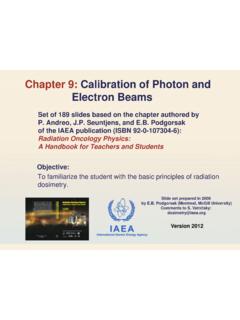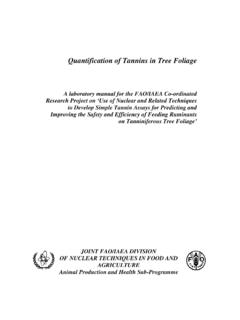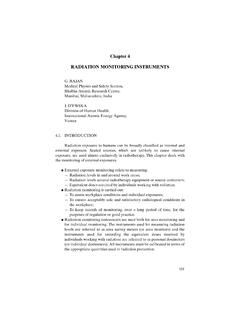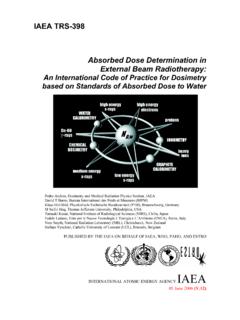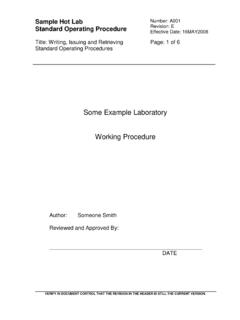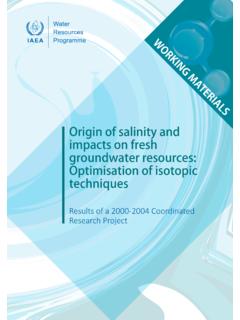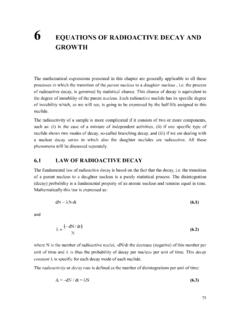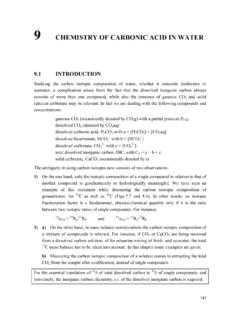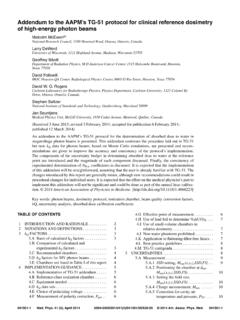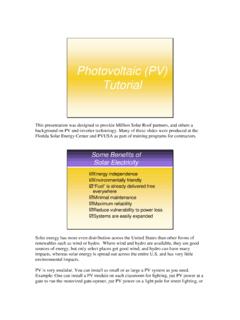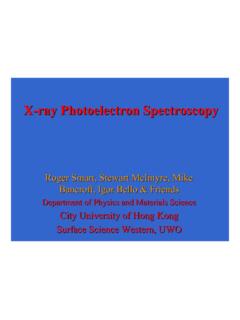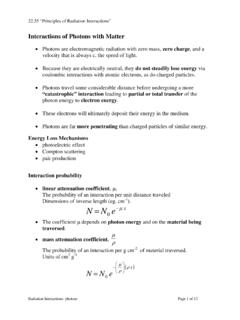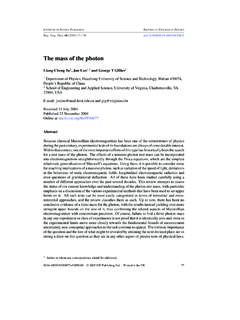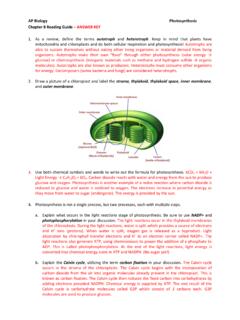Transcription of Chapter 6 EXTERNAL PHOTON BEAMS: PHYSICAL ASPECTS
1 161 Chapter 6 EXTERNAL PHOTON BEAMS: PHYSICAL PODGORSAKD epartment of Medical Physics,McGill University Health Centre,Montreal, Quebec, INTRODUCTIONR adiotherapy procedures fall into two main categories: EXTERNAL beam radiotherapy and brachytherapy. In EXTERNAL beam radiotherapy the radiation source is at a certain distance from the patient and the target within the patient is irradiated with an EXTERNAL radiation beam. In brachytherapy (see Chapter 13) radiation sources are placed directly into the target volume (intracavitary or interstitial brachytherapy) or on to a target (surface mould or intraoperative radiotherapy).
2 Most EXTERNAL beam radiotherapy is carried out with PHOTON beams, some with electron beams and a very small fraction with more exotic particles such as protons, heavier ions or Chapter deals with EXTERNAL PHOTON beam radiotherapy. PHOTON EXTERNAL beams are all characterized by the same PHYSICAL parameters, but fall into various categories depending on their origin, means of production and energy. There are two origins of PHOTON beams: g rays, which originate from radioactive nuclei, and X rays, which originate in a target bombarded with energetic electrons.
3 The X rays from a target consist of bremsstrahlung photons and characteristic photons. X rays are produced either in an X ray tube (super-ficial or orthovoltage X rays) or in a linac (megavoltage X rays). QUANTITIES USED IN DESCRIBING A PHOTON BEAMR adiation dosimetry deals with two distinctly different entities: one describes the PHOTON radiation beam itself in terms of the number and energies of photons constituting the PHOTON beam and the other describes the amount of energy the PHOTON beam may deposit in a given medium such as air, water or biological fluence and PHOTON fluence rate The PHOTON fluence f is defined as the quotient dN by dA, where dN is the number of photons that enter an imaginary sphere of cross-sectional area dA:( )The unit of PHOTON fluence f is cm PHOTON fluence rate is defined as the PHOTON fluence per unit time.
4 ( )The unit of PHOTON fluence rate is cm 2 s fluence and energy fluence rateThe energy fluence Y describes the energy flow in a PHOTON beam and is defined as the amount of energy dE crossing a unit area dA:( )The unit of energy fluence Y is a monoenergetic beam, dE is the number of photons dN times their energy hn, and the energy fluence Y in terms of PHOTON fluence f is:Y = fhn( )The energy fluence rate Y is defined as the energy fluence per unit time:( )The unit of energy fluence rate is MeV cm 2 s ddNAjf=ddt dd=EAY=ddytEXTERNAL PHOTON BEAMS: PHYSICAL kerma in airFor a monoenergetic PHOTON beam in air the air kerma in air (Kair)air at a given point away from the source is proportional to the energy fluence Y or PHOTON fluence f as follows:( )where (mtr/r)air is the mass energy transfer coefficient for air at PHOTON energy K consists of two components: the collision kerma Kcol and the radiative kerma Krad.
5 K = Kcol + Krad ( )For monoenergetic photons in air the collision kerma Kcol is proportional to Y and f through the following relationship:( )where (mab/r)air is the mass energy absorption coefficient for air at PHOTON energy hn. Often in the literature the energy absorption coefficient mab is denoted as men. The mass energy transfer coefficient (mtr/r) and mass energy absorption coefficient (mab/r) are related through the following relationship:( )where is the radiative fraction ( the fraction of the energy of secondary charged particles (electrons) that is lost to bremsstrahlung rather than being deposited in the medium).
6 For low atomic number Z materials and PHOTON energies below 1 MeV, the radiative fraction , ( tr/r) ( ab/r) and K Kcol.()Khair airtrairtrair = = ymrfnmrKhcolabairabair = = ymrnfmrmrmrabtr=-()1ggg 0 Chapter in airThe collision air kerma in air is related to exposure in air Xthrough the following relationship:( )where (Wair/e), as discussed in Section , is the average energy required to produce an ion pair in dry air ( eV/ion pair). The special unit of exposure is the roentgen (R), while the SI unit is 10 4 C/kg with 1 R = 10 4 C/kg.
7 Thus:( )with the exposure X given in to small mass of medium in airThe concept dose to small mass of medium in air , also known as dose in free space , was introduced by Johns and Cunningham to characterize the output of a radiation unit and to gain a reference dose for dosimetric calcula-tions involving tissue air ratios (TARs) and peak scatter factors (PSFs). The dose to small mass of medium in air is designated as D med and is based on a measurement of the air kerma in air. The concept has gained widespread use in orthovoltage and 60Co therapy, but is of limited use in megavoltage linac beam steps involved in determining the dose to small mass of medium in air D med at point P in a radiation beam from a signal MP measured with an ionization chamber centred at point P in air are:( )where MP is the signal measured with an ionization chamber at point P and corrected for influence quantities such as air temperature, air pressure and recombination loss (see Section ).
8 The ionization chamber should have an ()Kaircolair()/)KXWeaircolairair(=()..KX aircolairairCkg R JCcGyR= = -258 10339708764 X MX KKKmPPair airairmed air ( ( ()()()()(()))12345D)) med DEXTERNAL PHOTON BEAMS: PHYSICAL ASPECTS165appropriate buildup cap and an exposure calibration coefficient in air NX or an air kerma in air calibration coefficient NK. Step 1: Determine XP , the exposure at point P, through:XP = MP NX( ) Step 2: Determine (Kair)air, the air kerma in air at point P, through:( )Alternatively, (Kair)air may be determined from MP directly, if NK for the chamber is known, as follows:(Kair)air = MPNK ( ) Step 3: Determine collision kerma to Dm, an infinitesimal mass of any other material ( water), in air from.
9 ( )where is the ratio of spectrum averaged mass energy absorption coefficients for Dm and air. Step 4: Determine collision kerma to a spherical mass of medium centred around P and having a radius rmed just large enough to provide charged particle equilibrium (CPE) at point P:(Kmed)air = (KDm)air(rmed)( )where k(rmed) is a correction factor accounting for the PHOTON beam attenuation in the spherical mass of medium and approximated as:( )( ab/r)med in Eq. ( ) is the mass energy absorption coefficient and r is the density of the medium.
10 For water, which is usually chosen as the ()KXair ()()KKmmDDairair airabair = mr(/)mrabairDmkrer()medabmedmed - mrrCHAPTER 6166medium, k(rmed) for 60Co photons and approximately 1 for lower PHOTON energies. Step 5: Dose to small mass of medium in free space D med is obtained from the following relationship:( )where b is a proportionality constant equal to , and for 60Co, 137Cs and X rays below 350 kVp, respectively. Often b is assumed equal to 1, even for 60Co g product:is usually referred to as the roentgen to cGy conversion factor fmed, and the dose to small mass of medium in air , assuming that b 1, can then be written as:D med = fmed Xk(rmed)( ) PHOTON BEAM SOURCESP hoton sources are either isotropic or non-isotropic and they emit either monoenergetic or heterogeneous PHOTON beams.
